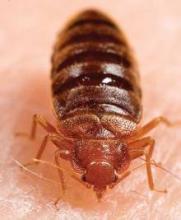User login
In recent years, the United States has seen an increase of bedbug infestations, according to the Centers for Disease Control and Prevention. However, the chemicals used to eradicate the bugs are causing more harm than are the bugs themselves.
In all, 111 illnesses and one fatality caused by improper use of insecticides were reported in seven states in 2003-2010, according to the CDC’s Morbidity and Mortality Weekly Report. The report analyzed cases in California, Florida, Michigan, North Carolina, New York, Texas, and Washington.
The analysis showed that illnesses resulted most commonly from excessive insecticide application, lack of notification of pesticide application, and not washing or changing insecticide-treated bedding. In addition, 39% of pesticide applications were done by people living in the home who weren’t certified to apply the pesticides. Private homes were the site of 43% of the illnesses; 40% occurred in multiunit housing. Hotels were the source of only 3% of illnesses. A majority (67%) of illnesses occurred in people aged 25 years or older.
The most common symptoms of illness were headaches and dizziness (40% of cases), respiratory symptoms (40%), and gastrointestinal issues including nausea and vomiting (33%). New York City had the most cases of insecticide-related illness, representing 58% of cases (MMWR 2011;60:1269-74).
However, 81% of cases were considered low severity. The report also showed that 89% of the illness-causing insecticide exposures, including the fatality, were to pyrethroids, pyrethrins, or both, and were in toxicity category III.
Bedbugs themselves do not carry disease, and the CDC recommends using nonchemical methods for treating an infestation. For example, infested rooms can be heated to 118° F or cooled to 3° F for 1 hour. The CDC also recommends vacuuming, steaming, laundering, or disposing of infested items, and encasing mattresses and box springs in bedbug-proof covers.
In recent years, the United States has seen an increase of bedbug infestations, according to the Centers for Disease Control and Prevention. However, the chemicals used to eradicate the bugs are causing more harm than are the bugs themselves.
In all, 111 illnesses and one fatality caused by improper use of insecticides were reported in seven states in 2003-2010, according to the CDC’s Morbidity and Mortality Weekly Report. The report analyzed cases in California, Florida, Michigan, North Carolina, New York, Texas, and Washington.
The analysis showed that illnesses resulted most commonly from excessive insecticide application, lack of notification of pesticide application, and not washing or changing insecticide-treated bedding. In addition, 39% of pesticide applications were done by people living in the home who weren’t certified to apply the pesticides. Private homes were the site of 43% of the illnesses; 40% occurred in multiunit housing. Hotels were the source of only 3% of illnesses. A majority (67%) of illnesses occurred in people aged 25 years or older.
The most common symptoms of illness were headaches and dizziness (40% of cases), respiratory symptoms (40%), and gastrointestinal issues including nausea and vomiting (33%). New York City had the most cases of insecticide-related illness, representing 58% of cases (MMWR 2011;60:1269-74).
However, 81% of cases were considered low severity. The report also showed that 89% of the illness-causing insecticide exposures, including the fatality, were to pyrethroids, pyrethrins, or both, and were in toxicity category III.
Bedbugs themselves do not carry disease, and the CDC recommends using nonchemical methods for treating an infestation. For example, infested rooms can be heated to 118° F or cooled to 3° F for 1 hour. The CDC also recommends vacuuming, steaming, laundering, or disposing of infested items, and encasing mattresses and box springs in bedbug-proof covers.
In recent years, the United States has seen an increase of bedbug infestations, according to the Centers for Disease Control and Prevention. However, the chemicals used to eradicate the bugs are causing more harm than are the bugs themselves.
In all, 111 illnesses and one fatality caused by improper use of insecticides were reported in seven states in 2003-2010, according to the CDC’s Morbidity and Mortality Weekly Report. The report analyzed cases in California, Florida, Michigan, North Carolina, New York, Texas, and Washington.
The analysis showed that illnesses resulted most commonly from excessive insecticide application, lack of notification of pesticide application, and not washing or changing insecticide-treated bedding. In addition, 39% of pesticide applications were done by people living in the home who weren’t certified to apply the pesticides. Private homes were the site of 43% of the illnesses; 40% occurred in multiunit housing. Hotels were the source of only 3% of illnesses. A majority (67%) of illnesses occurred in people aged 25 years or older.
The most common symptoms of illness were headaches and dizziness (40% of cases), respiratory symptoms (40%), and gastrointestinal issues including nausea and vomiting (33%). New York City had the most cases of insecticide-related illness, representing 58% of cases (MMWR 2011;60:1269-74).
However, 81% of cases were considered low severity. The report also showed that 89% of the illness-causing insecticide exposures, including the fatality, were to pyrethroids, pyrethrins, or both, and were in toxicity category III.
Bedbugs themselves do not carry disease, and the CDC recommends using nonchemical methods for treating an infestation. For example, infested rooms can be heated to 118° F or cooled to 3° F for 1 hour. The CDC also recommends vacuuming, steaming, laundering, or disposing of infested items, and encasing mattresses and box springs in bedbug-proof covers.
FROM MORBIDITY AND MORTALITY WEEKLY REPORT
Major Finding: In all, 111 illnesses and one fatality caused by improper use of bedbug insecticides were reported in 2003-2010.
Data Source: An analysis of data from seven states.
Disclosures: The investigators reported no relevant financial disclosures.
